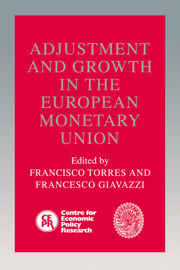Book contents
- Frontmatter
- Contents
- List of figures
- List of tables
- Preface
- List of contributors
- Foreword
- 1 Introduction
- 2 Economic and monetary union: critical notes on the Maastricht Treaty revisions
- Discussion
- 3 The design of optimal fiscal rules for Europe after 1992
- Discussion
- 4 Contracts, credibility and common knowledge: their influence on inflation convergence
- Discussion
- 5 Inflation in fixed exchange regimes: the recent Portuguese experience
- Discussion
- 6 Models of economic integration and localized growth
- Discussion
- 7 Shocking aspects of European monetary integration
- Discussion
- 8 Lessons of Massachusetts for EMU
- Discussion
- 9 Financial and currency integration in the European monetary system: the statistical record
- Discussion
- 10 Currency substitution: from the policy questions to the theory and back
- Discussion
- 11 Coordination of capital income taxes in the economic and monetary union: what needs to be done?
- Discussion
- Index
3 - The design of optimal fiscal rules for Europe after 1992
Published online by Cambridge University Press: 29 January 2010
- Frontmatter
- Contents
- List of figures
- List of tables
- Preface
- List of contributors
- Foreword
- 1 Introduction
- 2 Economic and monetary union: critical notes on the Maastricht Treaty revisions
- Discussion
- 3 The design of optimal fiscal rules for Europe after 1992
- Discussion
- 4 Contracts, credibility and common knowledge: their influence on inflation convergence
- Discussion
- 5 Inflation in fixed exchange regimes: the recent Portuguese experience
- Discussion
- 6 Models of economic integration and localized growth
- Discussion
- 7 Shocking aspects of European monetary integration
- Discussion
- 8 Lessons of Massachusetts for EMU
- Discussion
- 9 Financial and currency integration in the European monetary system: the statistical record
- Discussion
- 10 Currency substitution: from the policy questions to the theory and back
- Discussion
- 11 Coordination of capital income taxes in the economic and monetary union: what needs to be done?
- Discussion
- Index
Summary
Introduction
As the countries in the European Community are debating whether, when and how to move to a full economic and monetary union (EMU), the compatibility of such a move with independent and divergent fiscal policies of the member countries has become an important issue. While the experience of the European monetary system (EMS) has shown that an exchange rate constraint might tie the hands of monetary authorities and lead to a convergence of monetary policies and inflation rates, a similar convergence of the fiscal policies of the EC countries has not been observed. On the contrary, the period from 1979–87 was characterized by a divergence of fiscal policies in the member countries, with large budget deficits in a number of them. In the cases of Italy, Belgium, Ireland, Greece, Portugal and the Netherlands, these deficits led to a significant increase in the public debt to gross domestic product (GDP) ratio (see Tables 3.1 and 3.2). Since 1987, the fiscal balances of a number of these countries have improved; significant primary surpluses in Belgium and Ireland have led to a reduction in their debt-to-GDP ratios. In Italy, Greece and the Netherlands, however, the fiscal adjustment in the last few years has not been sufficient to prevent further increases in this ratio.
- Type
- Chapter
- Information
- Adjustment and Growth in the European Monetary Union , pp. 46 - 82Publisher: Cambridge University PressPrint publication year: 1993
- 12
- Cited by



